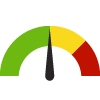Indicator Gauge Icon Legend
Legend Colors
Red is bad, green is good, blue is not statistically different/neutral.
Compared to Distribution
 the value is in the best half of communities.
the value is in the best half of communities.
 the value is in the 2nd worst quarter of communities.
the value is in the 2nd worst quarter of communities.
 the value is in the worst quarter of communities.
the value is in the worst quarter of communities.
Compared to Target
 meets target;
meets target;  does not meet target.
does not meet target.
Compared to a Single Value
 lower than the comparison value;
lower than the comparison value;
 higher than the comparison value;
higher than the comparison value;
 not statistically different from comparison value.
not statistically different from comparison value.
Trend

 non-significant change over time;
non-significant change over time; 
 significant change over time;
significant change over time;  no change over time.
no change over time.
Compared to Prior Value
 higher than the previous measurement period;
higher than the previous measurement period;
 lower than the previous measurement period;
lower than the previous measurement period;
 no statistically different change from previous measurement period.
no statistically different change from previous measurement period.
 Significantly better than the overall value
Significantly better than the overall value
 Significantly worse than the overall value
Significantly worse than the overall value
 No significant difference with the overall value
No significant difference with the overall value
 No data on significance available
No data on significance available
Elder Index (Elderly Household Below Income Threshold)
This indicator is archived and is no longer being updated. Click to learn more
Why is this important?
Low-income elders depend upon public programs like Medi-Cal and cash assistance to make ends meet. The Federal Poverty Level (FPL) guidelines are often used to determine income eligibility for such programs. The FPL has not been adapted to changing standards of living and spending patterns over the years, and it does not take into account the local cost of living, which is a significant disadvantage in high-cost states such as California. UCLA Center for Health Policy's Elder Economic Security Index goes beyond the FPL guidelines and includes the "hidden poor"--older adults with incomes above the FPL but below a minimally decent standard of living.
Measurement period: 2019-2020
Maintained by: Conduent Healthy Communities Institute
Last update: December 2021
Graph Selections
Data Source
- California Health Interview Survey
Note: This source uses Zip Code Tabulation Areas (ZCTAs) for its Zip Code data. Learn more
Maintained By: Conduent Healthy Communities Institute (Methodology)
Filed under: Health / Older Adults, Social Determinants of Health, Older Adults


